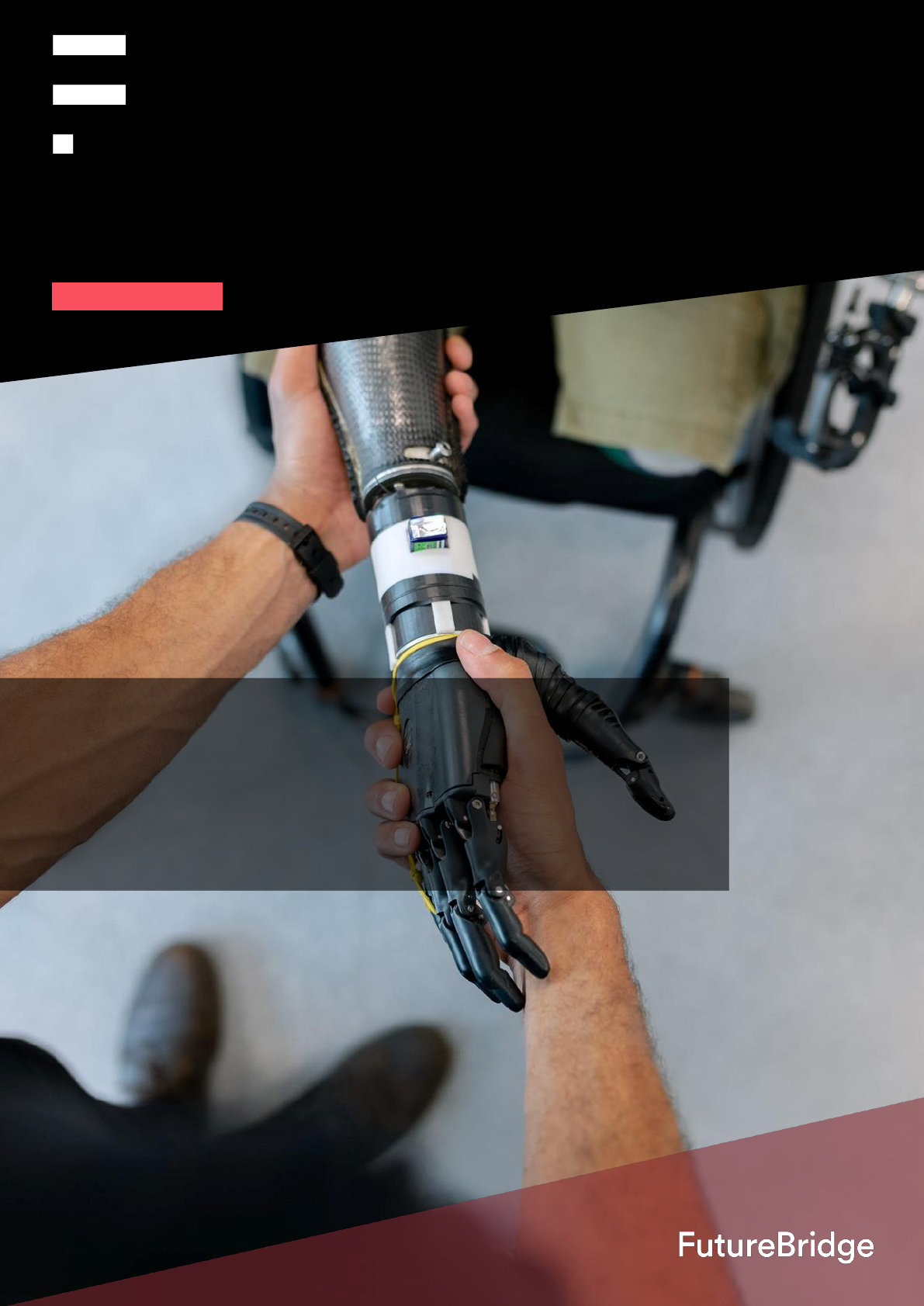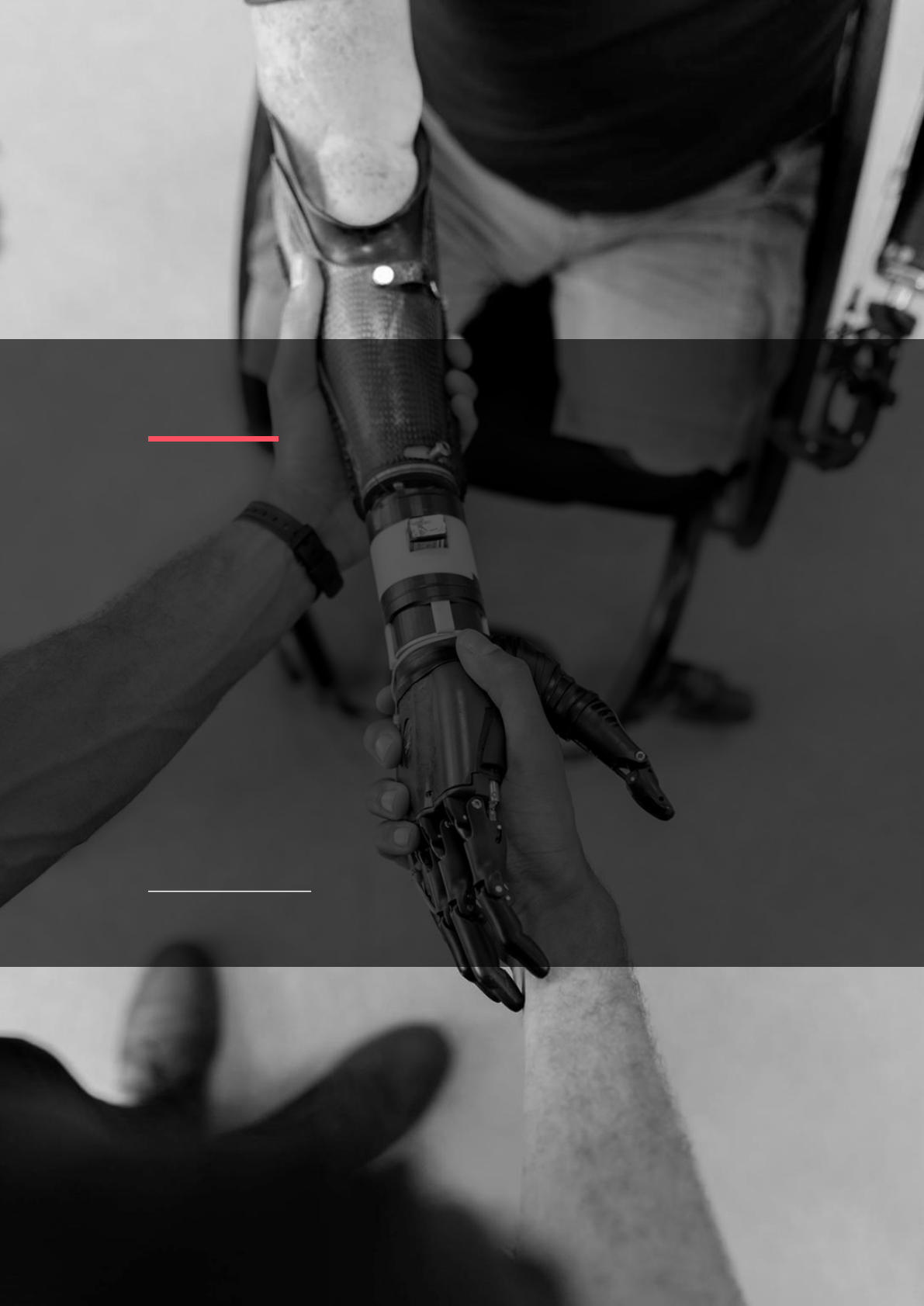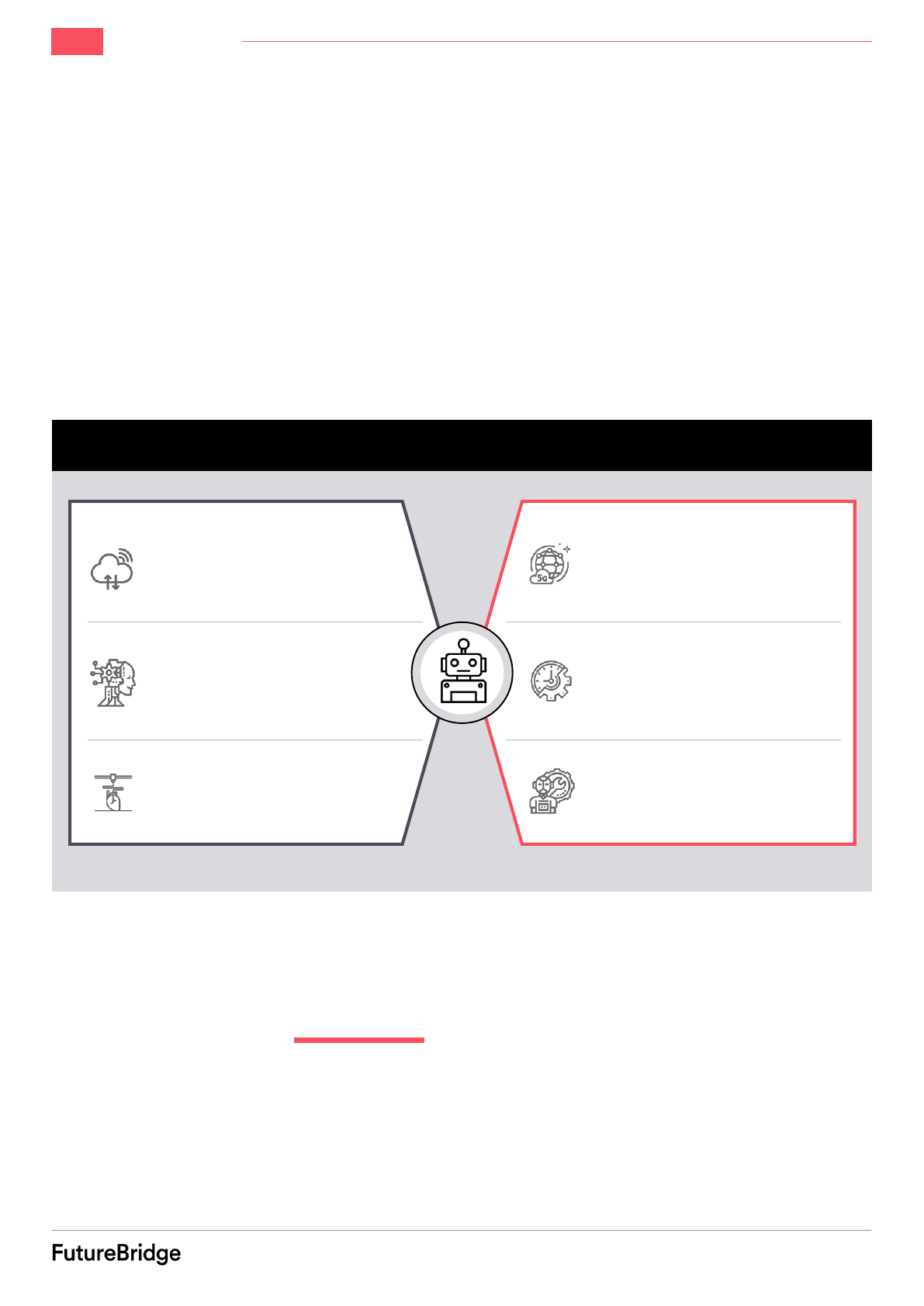
WHITE PAPER
Robots are Revolutionizing
Healthcare Industry
2021

1
White Paper | 2021
Robots are Revolutionizing Healthcare Industry
The main aim of robots in healthcare is to improve and support
the functioning of medical interventions, disabled individuals,
care, and rehabilitation. Eventually, it improves the quality of life
of patients and healthcare professionals. Integration of medical
robots with advanced technologies such as artificial intelligence,
IoT, and bioprinting would define the future of robotics. A wave of
innovations is predicted by looking at the investments from many
companies and governments in the sector. These innovations
may be aimed at resolving current unmet needs of robots such
as high price, precision, on-the-spot decision making just as the
human mind, emotional intelligence, and situational behavior.
futurebridge.com

2
White Paper | 2021
Robots are Revolutionizing Healthcare Industry
Note: RED marked timeline is for surgical robotic evolution
Source: FutureBridge analysis
Introduction
The word ‘robot’ was coined by the Robotic Institute of America in the 1940s as a
machine that performs the mechanical functions of a human being but lacks
sensitivity as that of a human being. Initially, the robots were designed to work like
humans, but later it was observed that they can be used for a lot more applications
due to their ability of multitasking in a much efficient and faster way. In the last few
decades, the utilization of robotic devices has evolved from spearheading tests in an
automated medical procedure to the broad utilization of robots in pretty much every
part of the healthcare sector. Exhibit 1 represents the evolution of medical robots
over the last few decades.
EXHIBIT 1: Evolution of medical robots
da Vinci - First
animal study for
head and neck
region
da Vinci -
First Robot
approved for
laparoscopic
surgery
2017
Sensei -
Specialized
robotic catheter
system
Smart Pills/
Micro bots -
Monitor inner
body functionality
in real time
Pharma-Botics-
Vending machine
for dispensing
drugs
Penelope -
Introduction of
robotic scrub
nurse
Orthoses (AKA
Exoskeletons) -
Useful for
correcting
malformations
IESOP - First FDA
approved robotic
surgical system
for positioning
endoscopes
Puma560 -
First Surgical
robot utilized for
brain biopsies
1960 2000
IBM 650 -
Scans medical
records for
subtle
abnormalities
Gamma Knife -
Computer-
assisted dose
planning
program
Shakey - First
mobile robot
introduced by
SRI
RB5X - First
personal robot
manufactured
by Robotics
Corp.
1966
1980
1974 1982
1990 2003
2005
2007
2013
2015
Medical robotics is causing a change in outlook in treatment and diagnostics..
Robotics provides a better solution for the healthcare and medical industry through
many benefits such as cost reduction of medical treatment, minimizing the risk of
surgical procedures, time-saving, and improvement of healthcare outcomes.
Robotically driven healthcare has helped in improving the treatment outcomes with
negligible error encounters, thereby improving patient experience.
The robotic applications are extensive and have contributed specifically to the
enrichment of the surgical sub‐specialties based on advantages such as increased
surgeon control and autonomy, superior instrument dexterity and tissue handling,
improved three‐dimensional visualization, and improved accuracy in complex

3
White Paper | 2021
Robots are Revolutionizing Healthcare Industry
procedures. The da Vinci surgery system was the first FDA-approved (2000) robotic
system encompassing surgical instruments and camera/scope devices. The “Endo-
wrist” features of the da Vinci surgery system precisely replicate skilled movements
of a surgeon at the controls. Since then it has become one of the most ubiquitous
and recognized systems throughout the world in the robotic surgery era, which
served as the building block for future robotic surgeries.
1
Developed countries are fueling innovations in this sector through loads of
investments. European Commission aims at accelerating the research and
development in robotics for healthcare with the commencement of a new research
project through €16 million funding . The world’s elderly population of age 60 years
and above is expected to reach 78 million according to the US Census, which
means there will be a significant shortage of nurses to take care of elderly people.
The rise in robotic nurses is expected by 2035 and the market is expected to reach
$480 million between 2015 and 2020.
Prominent surgical robots like Da Vinci developed by Intuitive Surgical have
completed five million surgeries in 2018. More than 4,500 surgical robots are sold by
the company worldwide. Intuitive Surgical expanded its footprint in Sunnyvale in
2019 by investing over $15 million. Such investments underline massive success in
surgical robots .
Medical robots are capable of carrying out a wide range of functions, ranging from
assisting surgeons in performing minimally invasive surgeries, to performing clinical
diagnostics. In broad terms, medical robotics can be used in the following various
forms:
Minimally invasive surgical robots: Assist physicians to perform surgeries with
high accuracy and minimally invasive surgical procedures
Diagnostic devices: Capture and process the information essential for effective
medical treatment
Advanced prosthetic: Mind-controlled prosthetics to aid in coordination and
mobility
Telepresence technology: Advanced video conferencing to provide stimuli to
the user's senses that make them feel as though they are in another place
Hospital automation: Automated robots to give medications to the patients and
safely disinfect rooms and surfaces
Assistant robots: Assist the patients requiring medical attention

4
White Paper | 2021
Robots are Revolutionizing Healthcare Industry
Reasons inhibiting robots to be
mainstream
The Gartner research has suggested that one in three jobs that exist today will be
converted to smart machines, robots, and softwares by 2025. However, there are a
few job sectors where robots dare not venture, where human intelligence still beats
artificial intelligence perception and manipulation, social intelligence, and creativity.
Sympathy & Empathy: A robot can personalize all the elements of the customer
relationship, but only humans can make a relationship truly personal. E.g.
calming an angry or panicked patient, humans outperform as robots are pre-
written programs with limited emotions, while humans are equipped with diverse
emotions related to diverse situations.
Social intelligence: Social intelligence is another bottleneck, as machines can’t
yet compete with humans at work involving negotiation, persuasion, or care. In
particular, machines struggle to recognize and respond to human emotions.
Creative thinking: Algorithms are getting systematically better. This means that
robots are now excellent at predicting customer behavior but cannot still form
new and valuable ideas such as poetry, music, recipes, jokes, fashion design, or
scientific theories.
Perception and manipulation: Humans outpace robots when it comes to
perception and motor skills, especially in unstructured work environments such
as surgeries. Robots can perform minimally invasive surgeries, thus improving
precision and speeding recovery, but may be indecisive in case of any surgical
complications.
Factors encouraging the growth of
medical robots
Medical professionals use robots for everything from surgery and rehabilitation to
non-invasive general hospital and pharmacy applications. This usage shows no
signs of slowing down and is predicted to grow year on year. Table 1 shows how
robotics is assisting various stakeholders in the healthcare sector. The medical
robotics market has increased almost sevenfold since 2012. Today, a good
percentage of the world population is aging rapidly and co-morbidities will continue
to rise largely as a result of lifestyles associated with economic development such
as smoking, obesity, harmful consumption of alcohol, unhealthy diet, and sedentary
lifestyle. Further, the continuously changing landscape of healthcare has led to the

5
White Paper | 2021
Robots are Revolutionizing Healthcare Industry
emergence of several significant factors that are likely to strengthen the case for
more ambitious adoption of advanced medical technologies, including medical
robotics. Those factors include:
Chronic disease prevalence: According to the World Health Organization (WHO),
chronic disease growth is expected to rise by 57% by the year 2020. With this
disease growth rate, the need for automation in several aspects of the healthcare
sector is anticipated.
Shortage of healthcare providers: According to the United Nations Population
Fund (UNFPA), the world is aging rapidly; between 2015 and 2050, the proportion
of the world's population over 60 years will nearly double from 12% to 22%. By
2050, the world’s population of age 60 years and above is expected to reach 2
billion, up from 900 million in 2015. Therefore, a significant shortage of nurses to
take care of elderly people is expected, which will eventually increase the demand
for robotic nurses.
Growth of minimally invasive surgeries: The medical industry is inclining
towards less invasive surgical techniques offering effective treatment to patients,
reducing the recovery time, and improving the clinical success rate. In some cases,
medical robotic devices have outperformed invasive surgeries.
Shortage of trained medical personnel: By the year 2030, the shortfall of
physicians in the US is projected to exceed 100,000, with rural and underserved
populations expected to be especially hard hit. Thus, to overcome such a situation
advanced medical robotics could play an important role in addressing the shortage.
Source: FutureBridge analysis
TABLE 1: Implementation of robotics to assist various stakeholders in healthcare sector
Stakeholder Role Implementation
Physicians
Accurate choice of therapy
Documentation of structured data
Reducing surgical risks
Remote patient monitoring
Implementation of artificial intelligence in choosing therapies
Analyzing large patient data set and performing data modelling
Robotic assistance in surgical techniques
Guidance to patients in an emergency via telemedicine
Nurses
Care of patient pool
Slicing off redundant tasks
Education
Large scale patient monitoring via virtual robotics
Generating alerts for human intervention in patient wards
Telepresence for teaching purposes
Care
-givers
Social assistance for the aging population
Home care assistance
Patient education
Old age patient care through socially assistive robotics
Engagement and interaction towards disease education and
identification
Hospitals
Mobile logistics
Data tracking
Medication dispensing
Autonomous robotic transport for medicine and surgical tools supply
Point of care medication dispensing through automated machinery
Pharmaceutical
companies
Manufacturing of personalized medicine
Reducing operational cost
Decreasing human errors
Automated drug discovery and development
Use of artificial intelligence for lead identification
Automation line through IoT integrated platforms for manufacturing
and packaging of drugs
Use of advanced robotics in screening and identifying drug candidates
Medical device
companies
Process streamlining
Assembly testing and inspection
Consistency in regulatory compliance
Sensory robotics offering efficient packaging of finished goods
Programmed path to maintain consistency in quality check and
regulatory compliance

6
White Paper | 2021
Robots are Revolutionizing Healthcare Industry
Application Examples
Robotic application has paved its way into the healthcare industry and its products in
the healthcare market. According to a published report, assisting in surgery, life
science research, and telemedicine are the most promising areas for robotic
applications in the healthcare industry. Exhibit 2 provides an illustrative list of entities
working on medical robots.
Source: FutureBridge analysis
EXHIBIT 2: Few active entities working on medical robots
Pharmaceutical &
medical device industry
Rehabilitation robots
Surgery robots
Care giving robots
Nursing robots
Medicine dispensing
robots
Research robots
Education robots
Nursing robots: Robotic nurses can be utilized for assistance in hospitals to
execute monotonous human-like physical activities.
‒ Robot Dinsow (CT Asia Robotics) can monitor elderly patients through
video and also provides alert notifications to the patients about their
medication time and dosage. The robot is currently used in Thailand and
Japan.
‒ Robot Pepper (Soft bank Robotics) is deployed at the reception of two
Belgian hospitals to guide the patients in the specific wardroom. Its unique
features consist of 20 language skills and can connect to the emotional
needs of individual patients.

7
White Paper | 2021
Robots are Revolutionizing Healthcare Industry
‒ Dustin (Duquesne University) is a telemedicine robotic platform that can
interact with students once connected via the iPad or any computer. It also
provides live video assistance in case of emergencies.
Research robots: Smart robots can accelerate the drug development process in
the pharmaceutical/biotechnology field using advanced research capabilities such
as artificial intelligence, big data analysis, etc.
‒ Eve (Cambridge, Wales, and Manchester University) is a drug discovery
robot that is created by the collaborative efforts of three universities. The
major advantage includes its rapid ability to screen 1000 compounds in a
single day, which has led to the discovery of an anti-malarial drug.
‒ Bioxcel Therapeutics is developing an AI platform to rapidly identify new
candidates in the immune-oncology and neuroscience fields. Many other
start-ups such as Genomics, Arcotris, etc. are enabling advanced robotic
solutions to meet the current drug exploration activities.
Care-givers: Socially assistive robots can act as care providers to elderly
patients while in hospitals or home-based care and help in their daily chores.
These robots also provide reminders to patients about daily dosing time.
‒ Robot Paro bot (AIST) imitates seal voice to relax patients. It has five types
of sensors and is commonly used in extended care facilities and hospitals
to improve patient interaction with caregivers.
‒ Keepon robot developed by an individual by Hideki Kozima at NICT, Japan
is a unique robot that studies autistic behavioral changes in kids and
monitors mental health.
Patient education and counseling: Robots dedicated as an assistant in
providing medical education to patients directly. These bots perform tasks such
as disease diagnosis, clinic finding, and counseling to patients for utmost care
‒ Buoy Health has developed an AI-enabled platform that listens and
interacts with patients in real-time to identify symptoms and diagnose
disease.
‒ Gyant chatbot is another example of an AI-enabled real-time platform to
improve patient experience and assist them in identifying the disease,
doctors, or clinics.
Surgeons: Minimally invasive surgeries can be executed more precisely with
less significant pain using these robotic technologies.
‒ DaVinci system (Intuitive Surgical) is a ubiquitous robotic system with
precise incision capability. Surgeons can completely control the system
and perform complex surgeries with reduced risk. Moreover, this robot
assists surgeons in the execution of complex surgeries.
‒ Mako knee surgical robot (Stryker) enables the creation of patient-specific
3D models of knee joints based on CT scans obtained pre-operatively. The

8
White Paper | 2021
Robots are Revolutionizing Healthcare Industry
system is advantageous in severe knee inflammation, rheumatoid arthritis,
and post-traumatic arthritis.
Rehabilitation: The robots help disabled patients in standing up, balancing, and
gait.
‒ Orthoses is a robotic exoskeleton system that can assist paralyzed people
in limb motions. It works on pre-set user-defined commands feuded into
the robot but advances are being made towards mind-controlling features
for orthoses.
Carriers in hospitals: Robots can be used to transport medical equipment from
one destination to another without human intervention.
‒ Helpmate (Pyrix) is a carrier bot programmed to transport surgical tools, x-
ray images, food, and medication supplies from a point A to B within the
hospital.
Medication dispensation and medical assistance/education: The bots assist
medical personnel and improve working conditions in the hospital environment.
While some bots were created to provide virtual education and training to medical
professionals.
‒ Robot-Rx (Mckensson) is used in hospitals for automating personalized
medication processes. It acts like a vending machine that dispenses
medication through automated processing. Also, it monitors and creates
alerts on the depletion of medicines in-store.
‒ Quentus AI-based software platform automates and prioritizes patient
safety.
‒ Pediatric HAL (Gaumard Scientific) is a simulating bot that is used for the
training of nurses in pediatric care. This robot acts like a 5-year-old child
which can interact with nurses, this robot enables training candidates to
study symptoms and vital signs in diseased conditions.
Medical device industry & pharmaceutical research advancement: Industries
are working towards the development of robotic integrated advanced
technologies to improve manufacturing solutions, quality testing of products, and
finished product manufacturing.
‒ Delta-style M series has been deployed by Fanuc, a US-based company
for accurate and smart handling such as inline visual tracking and precision
handling to increase productivity.
‒ Delta robot solution (Sysmac) is an integrated robotic solution to reduce
problems related to production and reduce the programming time of the
manufacturers.
‒ CoLAB (collaborative laboratory) is developed by HighRes Biosolutions
that can test >30,000 compounds for drug efficacy and has a working
capacity of 24 hours a day.

9
White Paper | 2021
Robots are Revolutionizing Healthcare Industry
‒ 3Scan is a proprietary microscopic visualization system to generate 3D
spatial screening maps and has the capability to process >3000 tissue
slices.
Future of integrating robotics with advanced technologies.
The future of robotics in healthcare is predicted to be exponentially increasing.
Researchers and companies are trying to integrate robotics with advanced
technologies such as artificial intelligence, the internet of things (IoT), and
bioprinting. Exhibit 3 provides an illustrative application of robotics integrated
advanced technologies.
Source: FutureBridge analysis
EXHIBIT 3: Integration of robotics with advanced technologies
IoT
Bio printing
Artificial intelligence
Machine learning application of
assessment of Cancer, and other
chronic disease, e.g. Infervision’s
(Chinese startup) developed CT scan
technology that enhanced cancer
diagnosis by 50%
Creation of bio-bots mimicking natural
organisms, e.g. Rutger’s University
developed a soft robotic printable
material which can change dynamics of
biomedical engineering
Cloud-based & 5G services are being
deployed for remote patient monitoring
and alert care-givers about patient
conditions, e.g. Ministry of Healthcare in
Singapore is focusing on development
of preventive IoT healthcare
Drivers for adoption of robotics in
healthcare
Reduction in healthcare cost: The homecare robotic assistive systems have
replaced expensive patient care services and assisted in supporting the
independent living of the disabled and the aging population. Surgical robots are
economical in terms of decreased pre and post-operation costs and lengthy stays
at hospitals. The pharmacy and nursing robots achieve cost benefits by reducing
manpower and lowering error-free medication delivery.

10
White Paper | 2021
Robots are Revolutionizing Healthcare Industry
Reduce the time required for surgeries: Surgeons can perform the surgeries in
less time using robots due to their ability to help them in aligning the angles of
surgical tools on-target sites in all three dimensions during the surgery. With the
help of robots, surgeons can perform more surgeries with high precision and
success rate as compared to what they did without the use of robots.
Enhance supply chain: Automated systems help in transporting bulky supplies
such as medicines, surgical instruments, machines, etc. from one place to
another requiring minimal human efforts. The automated robot can move across
the hospital rooms, operating theatre, and other departments at any time to
provide programmed or on-demand deliveries.
Provide assistance or comfort to patients: There is a rapid increase in the
number of elderly patients across the world. They require much more attention to
perform basic chores. Robots can assist elderly patients to do basic chores such
as get out of bed, sit in a wheelchair, etc.
Improve patient recovery time: Using robots in critical surgeries minimizes the
chances of human errors. The keyhole surgery using robots can accurately work
through very small incisions resulting in rapid patient recovery.
Exhibit 4 illustrates a brief about the drivers and challenges for the adoption of
robotics in healthcare.
Source: FutureBridge analysis
EXHIBIT 4: Drivers & challenges for the adoption of robotics in healthcare
Training: requires hours of time from
doctors and nurses
Reduce the time required for
surgeries: more number of surgeries
in less time with high precision
Provide assistance to patients: performs
the basic chores of elderly patients
Enhance supply chain: automating
the transportation of medicines,
surgical instruments, etc.
Improve patient recovery time: facilitating minimally
invasive surgery resulting in repaid patient recovery
Huge energy consumption: an uninterrupted
power supply needed for long lasting operations
Privacy issues: risk of leakage of users'
personal and private medical information
Stringent regulations: long testing
period with huge incurred expenses
High capital investment: high cost of manufacturing
a robot having accuracy & precision as of humans
Liability Issues: concerns over accountability in case
of malfunctioning or any other adverse consequences
Reduced healthcare cost: reduces in-
patient care, pre and post- operation cost

11
White Paper | 2021
Robots are Revolutionizing Healthcare Industry
Challenges for the adoption of
robotics in healthcare
High capital investment: One biggest challenge of robotics in healthcare is its
cost of manufacturing. Building a robot that can accurately reproduce the way the
surgeon’s hand moves is quite costly, around $1M. Companies are coming up with
cost-effective robots using advanced technologies such as 3D printing. E.g., SS
Innovations has recently launched an affordable robotic surgical system that can
perform complex motion controls using the actin robotic control toolkit.
Extensive training: One of the major challenges of medical robots is the huge
amount of time invested in training them to perform the tasks. Hours of doctor’s and
nurse’s time is required for training a robot. Certification for some medical robots
requires 100+ hours of training.
Stringent regulations: Regulatory approval is one of the major roadblocks for
medical robots. The robot manufacturing companies have to follow rigorous
regulatory approval schemes from the US, European Union, Japan, and other
regulatory agencies. The approval requires a long testing period with huge incurred
expenses. To overcome these constrains the companies must be accustomed to
all the regulatory guidelines and well prepared with monetary planning.
Privacy issues: End-users of the robots are concerned about leakage of medical
information such as patient history, etc. The companies developing robots feed
huge data about users' personal and private medical information to train them using
advanced technologies like artificial intelligence and machine learning. This
information is prone to cyber-attacks that can be protected by adhering to safety
standards and security requirements by regulator bodies such as General Data
Protection Regulation (GDPR), ISO80001, and AAMI/UL2800 series of standards.
Huge energy consumption: Robots being electronic machines, have huge energy
requirements. They require an uninterrupted power supply, thus need new power
sources and energy harvesting technologies for long-lasting operations. Saft
batteries, a Chinese company has developed long-life, highly reliable nickel
batteries for robotics applications in defense, deep offshore, and healthcare to
address the issues of high energy supplies and uninterrupted power supply.
Liability issues: Due to the mechanical nature of the robots, it is impossible to
make them liable in case of malfunctioning or any other adverse consequences
that occurred during their usage. This could raise concerns related to accountability
amongst manufacturers, programmers, and providers. This issue can be
addressed by designing a legal regime identifying product liability.

12
White Paper | 2021
Robots are Revolutionizing Healthcare Industry
Conclusion
Robots are actively becoming part of the modern healthcare ecosystem benefiting
all the stakeholders across the value chain. Advances in sensors, communication,
and motion control technologies have facilitated medical robots to be more precise
and autonomous. The recent developments in surgical robots have widened the
scope from assisting surgeons to single-handedly perform complex surgeries. The
capability to sense, think, and act makes robotics a revolutionary technology for the
healthcare industry. With the pace of evolution of the medical robot, the major
factors that will play a role in the success in designing the robots for medical
applications are clinical safety, product safety, and quality management compliance.
The future lies in the integration of medical robots with advanced technologies such
as artificial intelligence, IoT, and bioprinting. With the introduction of 5G technology,
the field of robotics is further expected to counter latency-related issues. The funding
to researchers from the governments in the field will further pave the way towards
the use of medical robots for the welfare of humanity.

13
White Paper | 2021
Robots are Revolutionizing Healthcare Industry
References
1. NCBI Article
2. Danish Technological Institute
3. Ohio University
4. Electronicspecifier
5. Computer World
6. WHO
7. WHO
8. IHS Markit Report
9. Pittsburgh Life Sciences Greenhouse
10. Duquesne University School of Nursing
11. Institute For The Future
12. Cerner
13. Interesting Engineering
14. All On Robots
15. Fanuc
16. Omron
17. Alliance of Advanced BioMedical Engineering
18. New Atlas
19. Archer Soft
20. BSI
21. Built in
22. UL LLC
23. Robotics Business Review
24. Robotics Tomorrow
25. CSR Blog

futurebridge.com
Europe
Stadsplateau 7
3521 AZ Utrecht
The Netherlands
T: +31 30 298 2108
United Kingdom
5 Chancery Lane
London EC4A 1BL
United Kingdom
T: +44 207 406 7548
Asia Pacific
Millennium Business Park
Sector 3, Building # 4, Mahape
Navi Mumbai 400 710
India
T: +91 22 6772 5700
North America
55 Madison Ave, Suite 400
Morristown, NJ 07960
USA
T: +1 212 835 1590
